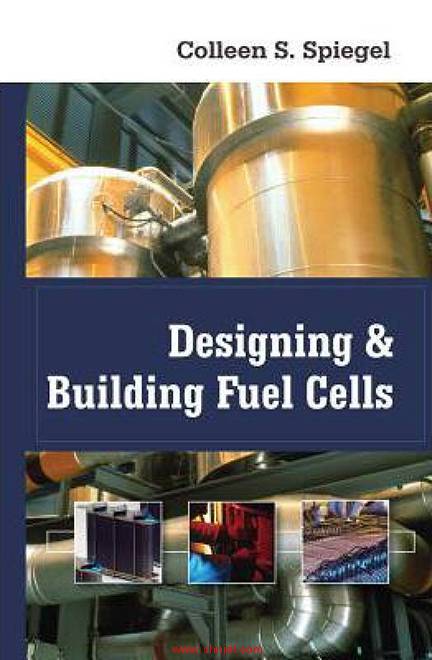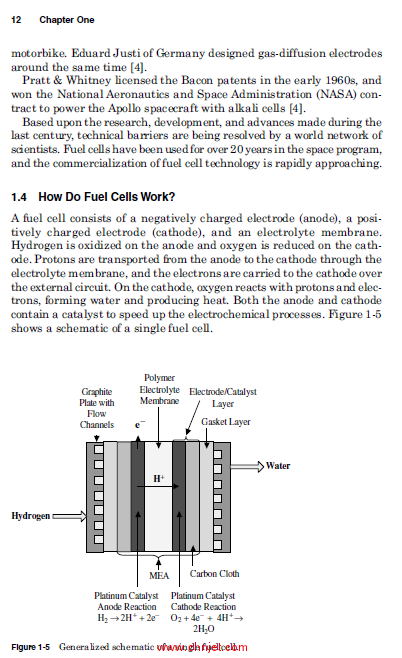马上注册,结交更多好友,享用更多功能,让你轻松玩转社区。
您需要 登录 才可以下载或查看,没有账号?立即注册

×
《Designing and Building Fuel Cells》
燃料电池的设计与建造
作者:Colleen Spiegel
出版社:Wiley
出版时间:2007年
《Designing and Building Fuel Cells》

《Designing and Building Fuel Cells》

《Designing and Building Fuel Cells》

《Designing and Building Fuel Cells》

目录
Foreword xii
Chapter 1. An Introduction to Fuel Cells 1
1.1 What Is a Fuel Cell? 3
1.1.1 Comparison with batteries 4
1.1.2 Comparison with heat engine 5
1.2 Why Do We Need Fuel Cells? 6
1.2.1 Portable sector 7
1.2.2 Transportation sector 7
1.2.3 Stationary sector 7
1.3 History of Fuel Cells 7
1.3.1 PEM fuel cells 9
1.3.2 Solid oxide fuel cells 10
1.3.3 Molten carbonate fuel cells 10
1.3.4 Phosphoric acid fuel cells 11
1.3.5 Alkali fuel cells 11
1.4 How Do Fuel Cells Work? 12
Chapter Summary 13
Problems 13
Bibliography 13
Chapter 2. Fuel Cells and the Hydrogen Economy 15
2.1 Characteristics of Hydrogen 16
2.1.1 Safety aspects of hydrogen as a fuel 18
2.2 World Energy Demand 19
2.3 Development of the Hydrogen Economy 21
2.4 Hydrogen Production, Distribution, and Storage 22
2.4.1 Technologies for hydrogen production 22
2.4.2 Technologies for hydrogen storage 24
2.4.3 Worldwide hydrogen refueling stations 25
v
2.5 Investment of Hydrogen Infrastructure 26
2.5.1 Government support 28
2.5.2 Long-term projections of hydrogen use 28
2.5.3 Key players in hydrogen R&D 29
Chapter Summary 33
Problems 33
Bibliography 34
Chapter 3. Fuel Cell Types 35
3.1 Polymer Electrolyte Membrane Fuel Cells (PEMFCs) 36
3.2 Alkaline Fuel Cells (AFCs) 39
3.3 Phosphoric Acid Fuel Cells (PAFCs) 40
3.4 Solid Oxide Fuel Cells (SOFCs) 42
3.5 Molten-Carbonate Fuel Cells (MCFCs) 43
3.6 Direct Methanol Fuel Cells (DMFCs) 44
3.7 Zinc Air Fuel Cells (ZAFCs) 46
3.8 Protonic Ceramic Fuel Cells (PCFCs) 47
3.9 Biological Fuel Cells (BFCs) 49
Chapter Summary 50
Problems 51
Bibliography 51
Chapter 4. Fuel Cell Applications 53
4.1 Portable Power 53
4.2 Backup Power 55
4.2.1 Basic electrolyzer calculations 56
4.3 Transportation Applications 57
4.3.1 Automobiles 58
4.3.2 Buses 66
4.3.3 Utility vehicles 66
4.3.4 Scooters and bicycles 69
4.4 Stationary Power Applications 72
Chapter Summary 83
Problems 84
Bibliography 84
Chapter 5. Basic Fuel Cell Thermodynamics 87
5.1 Basic Thermodynamic Concepts 87
5.2 Fuel Cell Reversible and Net Output Voltage 92
5.3 Theoretical Fuel Cell Efficiency 99
5.3.1 Energy efficiency 100
5.4 Fuel Cell Temperature 101
5.5 Fuel Cell Pressure 102
Chapter Summary 104
Problems 104
Bibliography 105
Chapter 6. Fuel Cell Electrochemistry 107
6.1 Electrode Kinetics 110
6.2 Voltage Losses 112
vi
Contents
vii
6.3 Internal Currents and Crossover Currents 116
6.4 Improving Kinetic Performance 117
Chapter Summary 118
Problems 118
Bibliography 119
Chapter 7. Fuel Cell Charge Transport 121
7.1 Voltage Loss Due to Charge Transport 121
7.2 Microscopic Conductivity in Metals 126
7.3 Ionic Conductivity in Aqueous Electrolytes 126
7.4 Ionic Conductivity of Polymer Electrolytes 127
7.5 Ionic Conduction in Ceramic Electrolytes 130
Chapter Summary 131
Problems 132
Bibliography 132
Chapter 8. Fuel Cell Mass Transport 133
8.1 Convective Mass Transport from Flow Channels
to Electrode 134
8.2 Diffusive Mass Transport in Fuel Cell Electrodes 135
8.3 Convective Mass Transport in Flow Structures 139
8.3.1 Mass transport in flow channels 139
8.3.2 Pressure drop in flow channels 144
Chapter Summary 149
Problems 149
Bibliography 150
Chapter 9. Heat Transfer 151
9.1 Fuel Cell Energy Balance 152
9.1.1 General energy balance procedure 152
9.1.2 Energy balance of fuel cell stack 154
9.1.3 General energy balance for fuel cell 154
9.1.4 Energy balance for fuel cell components and gases 155
9.2 Heat Generation and Flux in Fuel Cell Layers 158
9.3 Heat Conduction 158
9.4 Heat Dissipation Through Natural Convection
and Radiation 159
9.5 Fuel Cell Heat Management 160
9.5.1 Heat exchanger model 162
9.5.2 Air cooling 163
9.5.3 Edge cooling 166
Chapter Summary 167
Problems 168
Bibliography 168
Chapter 10. Fuel Cell Modeling 171
10.1 Conservation of Mass 175
10.2 Conservation of Momentum 175
Contents
10.3 Conservation of Energy 176
10.4 Conservation of Species 177
10.5 Conservation of Charge 178
10.6 The Electrodes 178
10.6.1 Mass transport 179
10.6.2 Electrochemical behavior 181
10.6.3 Ion/electron transport 183
10.6.4 Heat transport in the electrodes 184
10.7 The Electrolyte 185
Chapter Summary 186
Problems 187
Bibliography 187
Chapter 11. Fuel Cell Materials 189
11.1 Electrolyte Layer 190
11.1.1 PEMFCs and DMFCs 192
11.1.2 PAFCs 195
11.1.3AFCs 196
11.1.4 MCFCs 196
11.1.5 SOFCs 198
11.2 Fuel Cell Electrode Layers 199
11.2.1 PEMFC, DMFC, and PAFC catalysts 201
11.2.2 PEMFC, DMFC, and PAFC gas diffusion layers 205
11.2.3 AFC electrodes 207
11.2.4 MCFC electrodes 208
11.2.5 SOFC electrodes 208
11.3 Low-Temperature Fuel Cell Processing Techniques 210
11.4 SOFC manufacturing method 212
11.5 Method for Building a Fuel Cell 213
11.5.1 Preparing the polymer electrolyte membrane 213
11.5.2 Catalyst/electrode layer material 214
11.5.3 Hot-pressing the MEA 215
Chapter Summary 217
Problems 217
Bibliography 218
Chapter 12. Fuel Cell Stack Components and Materials 221
12.1 Bipolar Plates 221
12.1.1 Bipolar plate materials for low and medium
temperature fuel cells 223
12.1.2 Coated metallic plates 224
12.1.3 Composite plates 226
12.2 Flow-Field Design 227
12.3 Materials for SOFCs 232
12.4 Materials for MCFCs 233
12.5 PAFC Materials and Design 234
12.6 Channel Shape, Dimensions, and Spacing 235
12.7 Bipolar Plate Manufacturing 235
12.7.1 Nonporous graphite plate fabrication 235
12.7.2 Coated metallic plate fabrication 236
12.7.3 Composite plate fabrication 237
viii Contents
ix
12.8 Gaskets and Spacers 237
12.8.1 PEMFCs/DMFCs/AFCs 238
12.8.2 SOFC Seals 238
12.9 End Plates 240
12.10 Constructing the Fuel Cell Bipolar Plates, Gaskets,
End Plates, and Current Collectors 241
12.10.1 Bipolar plate design 241
12.10.2 Gasket selection 242
12.10.3 End plates 243
12.10.4 Current collectors 244
Chapter Summary 244
Problems 245
Bibliography 245
Chapter 13. Fuel Cell Stack Design 247
13.1 Fuel Cell Stack Sizing 249
13.2 Number of Cells 254
13.3 Stack Configuration 255
13.4 Distribution of Fuel and Oxidants to the Cells 260
13.5 Cell Interconnection 262
13.5.1 SOFCs 263
13.5.2 AFCs 264
13.6 Stack Clamping 264
13.7 Water Management for PEMFCs 265
13.7.1 Water management methods 266
13.8 Putting the fuel cell stack together 267
Chapter Summary 268
Problems 269
Bibliography 269
Chapter 14. Fuel Cell System Design 273
14.1 Fuel Subsystem 276
14.1.1 Humidification systems 276
14.1.2 Fans and Blowers 281
14.1.3 Compressors 284
14.1.4 Turbines 289
14.1.5 Fuel cell pumps 291
14.2 Electrical Subsystem 296
14.2.1 Power diodes 297
14.2.2 Switching devices 298
14.2.3 Switching regulators 300
14.2.4 Inverters 303
14.2.5 Supercapacitors 304
14.2.6 Power electronics for cellular phones 305
14.2.7 DC-DC converters for automotive applications 306
14.2.8 Multilevel converters for larger applications 307
14.3 Fuel Cell Hybrid Power Systems 308
14.4 System Efficiency 308
Chapter Summary 310
Problems 311
Bibliography 311
Contents
x Contents
Chapter 15. Fuel Types, Delivery, and Processing 313
15.1 Hydrogen 315
15.1.1Gas 315
15.1.2 Liquid 320
15.1.3 Carbon nanofibers 322
15.2 Other Common Fuel Types 324
15.2.1 Methanol 324
15.2.2 Ethanol 325
15.2.3 Metal hydrides 325
15.2.4 Chemical hydrides 328
15.2.5 Ammonia 331
15.2.6 Natural gas 333
15.2.7 Propane 333
15.2.8 Gasoline and other petroleumbased
fuels 333
15.2.9 Bio-fuels 334
15.3 Fuel Processing 334
15.3.1 Desulfurization 336
15.3.2 Steam reforming 337
15.3.3 Carbon formation 339
15.3.4 Internal reforming 339
15.3.5 Direct hydrocarbon oxidation 341
15.3.6 Partial oxidation 341
15.3.7 Pyrolysis 343
15.3.8 Methanol reforming 343
15.4 Bioproduction of Hydrogen 344
15.4.1 Photosynthesis 344
15.4.2 Digestion processes 345
15.5 Electrolyzers 346
15.5.1 Electrolyzer efficiency 347
15.5.2 High pressure in electrolyzers 347
Chapter Summary 348
Problems 349
Bibliography 349
Chapter 16. Fuel Cell Operating Conditions 353
16.1 Operating Pressure 353
16.2 Operating Temperature 356
16.3 Flow Rates of Reactants 357
16.4 Humidity of Reactants 361
16.5 Fuel Cell Mass Balance 363
Chapter Summary 370
Problems 370
Bibliography 371
Chapter 17. Fuel Cell Characterization 373
17.1 Fuel Cell Testing Setup 373
17.2 Verification of the Assembly 376
17.3 Fuel Cell Conditioning 376
17.4 Baseline Test Conditions and Operating Parameters 377
17.4.1 Temperature 378
17.4.2 Pressure 378
17.4.3 Flow rate 378
17.4.4 Compression force 378
17.5 Polarization Curves 378
17.6 Fuel Cell Resistance 380
17.6.1 Current interrupt 381
17.6.2 The AC resistance method 382
17.6.3 The high-frequency resistance (HFR) method 382
17.6.4 Electrochemical (EIS) impedance spectroscopy 383
17.6.5 Stoichiometry (utilization) sweeps 385
17.6.6 Limiting current 386
17.6.7 Cyclic voltammetry 387
17.7 Current Density Mapping 388
17.8 Neutron Imaging 388
17.9 Characterization of Fuel Cell Layers 388
17.9.1 Porosity determination 389
17.9.2 BET surface area determination 389
17.9.3 Transmission electron microscopy (TEM) 390
17.9.4 Scanning electron microscopy (SEM) 390
17.9.5 X-ray diffraction (XRD) 390
17.9.6 Energy dispersive spectroscopy (EDS) 390
17.9.7 X-ray fluorescence (XRF) 391
17.9.8 Inductively coupled plasma mass spectroscopy (ICP-MS) 391
Chapter Summary 391
Problems 392
Bibliography 392
Appendix A. Useful Constants and Conversions 395
Appendix B. Thermodynamic Properties of Selected Substances 397
Appendix C. Molecular Weight, Gas Constant and Specific Heat
for Selected Substances 399
Appendix D. Gas Specific Heats at Various Temperatures 401
Appendix E. Specific Heat for Saturated Liquid Water at Various
Temperatures 403
Appendix F. Thermodynamic Data for Selected Fuel Cell Reactants
at Various Temperatures 405
Appendix G. Binary Diffusion Coefficients for Selected Fuel Cell
Substances 413
Appendix H. Product Design Specifications 415
Appendix I. Fuel Cell Design Requirements and Parameters 417
Index 423
专业书籍
下载地址:(回复后可见)
| ![]()